General Admiral class armoured cruisers (1875)
 General-Admiral, Gerzog Edinburgski
General-Admiral, Gerzog Edinburgski
The first armoured cruisers ?
This pair of Russian Imperial ships are considered by John Francis Beeler (p. 222, British Naval Policy in the Gladstone-Disraeli Era, Stanford U 1997) to be the world’s first armoured cruisers. At that time, the Baltic has been pacified and now the old enemy of Russia was the Ottoman Empire, which boasted one of the most powerful fleets in the Mediterranean, counting dozens of ironclads, armoured frigates and corvettes. The Russian ships were classified first as “armored corvettes” before the plans were even laid down, then semi-armored frigates on 24 March 1875 as they were completed. In fact they resembled central battery ironclads, but to a smaller scale than actual capital ships. The armament was concentrated amidships and they had both a full sailing rig. The ships were named after, respectively, the Grand Duke Konstantin Nikolayevich of Russia and Alfred, Duke of Saxe-Coburg and Gotha. They entered service in 1875 and 1877 and had a fairly long and colorful career.
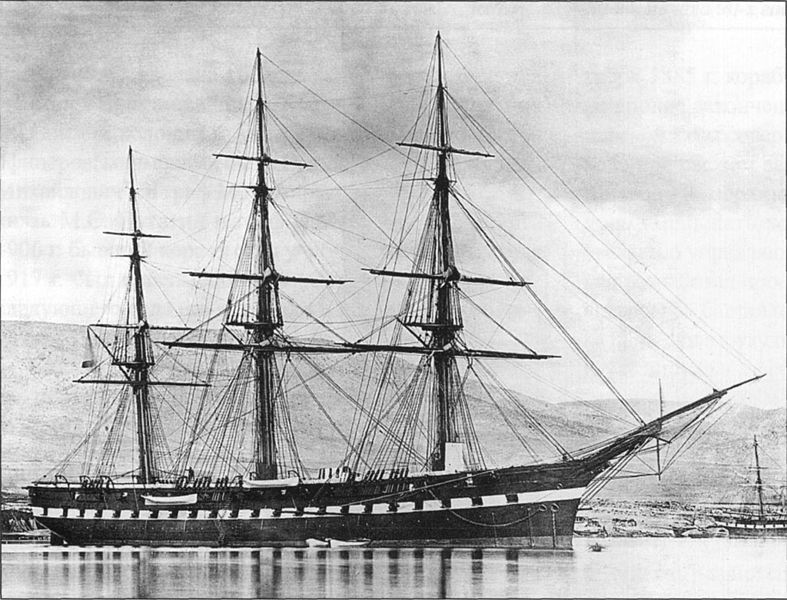
The previous General Admiral, 1857 Frigate of the line.
Design of the General Admiral
As built they displaced 400 long tons more than the original design (5,031 long tons (5,112 t)). They measured 87.1 m x 14.6 m x 7.4 m (draft) or 285 feet 10 inches x 48 feet x 24 feet 5 inches overall. The General Admiral was laid down on 27 November 1870 and launched on 2 September 1873 and entered service in 1875 while the Gerzog Edinburgski was started on 27 September 1870, launched on 10 September 1875 and in service in 1877. Although externally similar, with about a completely different machinery, both ships tried totally different gunnery arrangement, not only in numbers but also in caliber: As an example, for secondary artillery, the first had 87 mm guns and the second 107 mm.
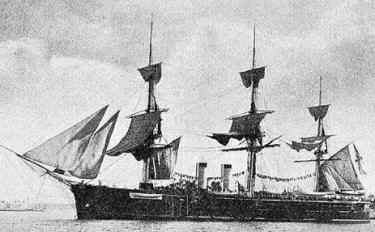
General Admiral under sail
Propulsion
They were propelled by a vertical compound steam engine fed by four to five cylindrical boilers (General Admiral), which drove a single two-bladed, 6.25 m propeller. Working pressure was 60 psi (414 kPa; 4 kgf/cm2) for 4,772 indicated horsepower (3,558 kW) and 12.3 knots (22.8 km/h; 14.2 mph) observed on sea trials on the General Admiral and 5,590 ihp (4,170 kW) for 11.5 knots (21.3 km/h; 13.2 mph) for the Gerzog Edinburgski, not precisely blazing speed. To save performances both missed a ram but had a clipper bow instead. For autonomy, both ships carried up to 1,000 long tons (1,000 t) of coal for 5,900 nautical miles (10,900 km; 6,800 mi) at 10 knots (19 km/h; 12 mph). When under sail they could reduce drag by folding their single funnel while the propeller could be hoisted into the hull.
Protection
The General Admiral and her sister-ship were given a complete waterline belt. It was made ofwrought iron and 6 in thick in the center section, declining to 5 in (127 mm) on both the ends. Its height was 2.15 m or 7 feet 1 inch, and 1.55m (5 feet 1 in) below the waterline while above, the central battery was 6 in thick, also with wrought iron armour plates.
Armament
Both ships, built at Nevskiy Works, and Baltic Works at Saint Petersburg had a completely different armament: General-Admiral was given six 203 mm (8 in) as well as two 152 mm (6 in) and four 87 mm (3.4 in) rifled breech-loading guns (RBL). Her sister ship however had four 203 mm guns, five 152 mm, and six 107 mm (4.2 in) guns. Apparently none had torpedo tubes.
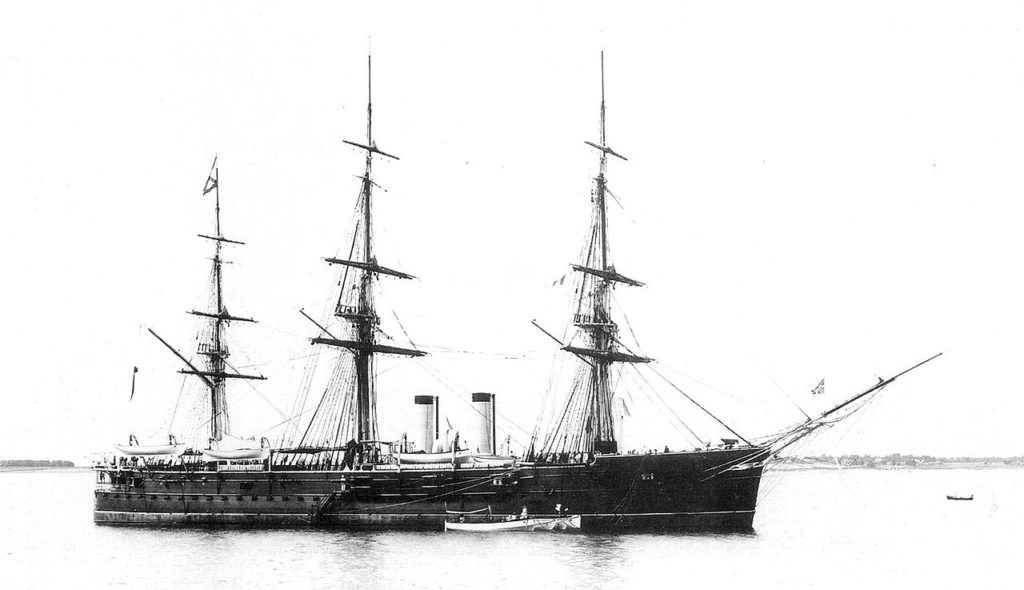
General Admiral. She was reformed circa 1906
Career of the General Admiral Cruisers
Like some other Russian ships of the same era, these ships had a fairly long career, although not always as cruisers. General-Admiral was caught in a heavy storm at Kronstadt in 1875 shortly after completion, went ashore and so she was towed to port for repairs. She therefore missed the Russo-Turkish War of 1877–78. After repairs, she sailed for the Pacific in the early 1880s and spent 1884–85 in the Mediterranean. In 1886 she was back home for a refit, partially re-boilered while her foldable funnel was replaced by two non-retractable models andd a fixed propeller later in 1892 eplace the removable model going back to th sailing era. She was reclassified as 1st-class cruiser on February 1892, and then sailed to Hampton Roads, Virginia in 1893 for a review. She became a training ship the next year, and in 1906 was completely converted in that new role, with her armament reduced to the minimum.
Gerzog Edinburgski served with the Baltic Fleet, made a Pacific cruise which lasted from 1881 to 1884, was refitted in 1890 with new boilers, a fixed funnel and later a fixed propeller later in 1897, together with new engines. She was then used as a training ship for petty officers and later converted and reclassified as a school ship in 1906. However this new career was again put to an end, when both ships were converted into minelayers in 1908–11. To free the name for more modern units, both were also renamed Saint Petersburg lake, Narova and Onega respectively. Their ancient rigging was removed and masts simplified to simple poles, the armament reduced to just four 75 mm or 3.0 in guns, but they could accomodate 600–800 mines.
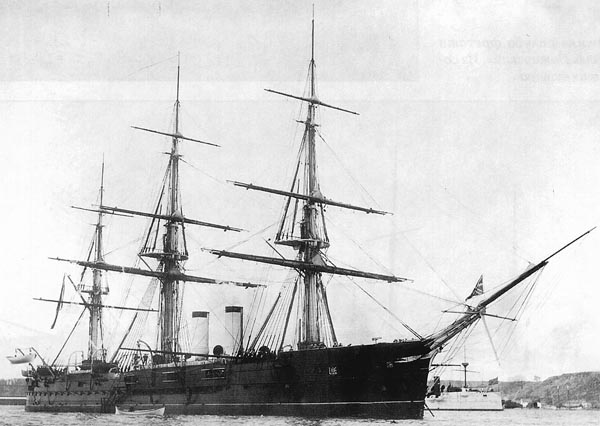
Gertsog Edinburgskiy
WW1: So as minelayers they took part in many missions in 1914-1915. By 1915 however, Onega was hulked and renamed Blokshiv No 9 used as a mine storage ship in Helsinki. The Narova, went on until 1918 in that role. According to The Treaty of Brest-Litovs, the Soviets evacuated Helsinki in March 1918 but both ships were not included in the evacuation before winter ice sets in. The Germans eventually agreed that they leave the harbor in May for Kronstadt. Under a soviet flag, Narova mined the approaches to Petrograd, empeding the British forces operating in the Gulf of Finland, and was finally renamed (third time) Dvadsatpyatavo Oktyabrya or “25 October” by 1922. Although her sister Blokshiv No. 9 was reported broken up in the 1920s, her sister-ship Dvadsatpyatavo Oktyabrya became also a mine storage hulk in 1938. She was afterwards sunk deliberately to served as a breakwater in the Neva River in 1959. At that time, given the fact she has been laid down in 1870, the cruiser was 90 years old !

Illustration of the International Squadron arriving at Suda Bay, Crete, on 21 December 1898. Behind Bugeaud, carrying Prince George of Greece and Denmark en route to Crete, is followed by Gerzog Edinburgski and the battleships HMS Revenge and Francesco Morosini behind.
Specifications (General Admiral) |
|
| Dimensions (L-w-h) | 87.1 m x 14.6 m x 7.4 m (285 x 48 x 24 ft) |
| Total weight, fully loaded | 5,031 long tons (5,112 t) |
| Armament | 6 × 203 mm, 2 × 152 mm, 2 × 86 mm, 8 × 37 mm, 1 × 381 mm sub TT |
| Armor | Belt: 5–6 in (127–152 mm) |
| Crew | 482 officers and sailors |
| Propulsion | 1 Shaft, 1 comp.st.engine 4 Cyl. boilers 4,772 ihp (3,558 kW) |
| Speed (road) | 14 knots (26 km/h; 16 mph) |
| Range | 5,900 nmi (10,900 km; 6,800 mi) at 10 knots (19 km/h; 12 mph) |
Gallery
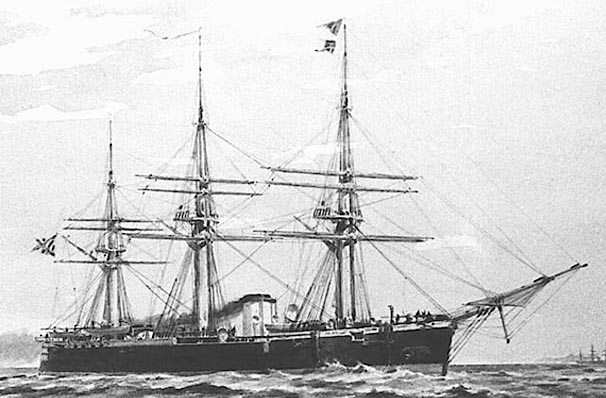
Engraving of the General Admiral
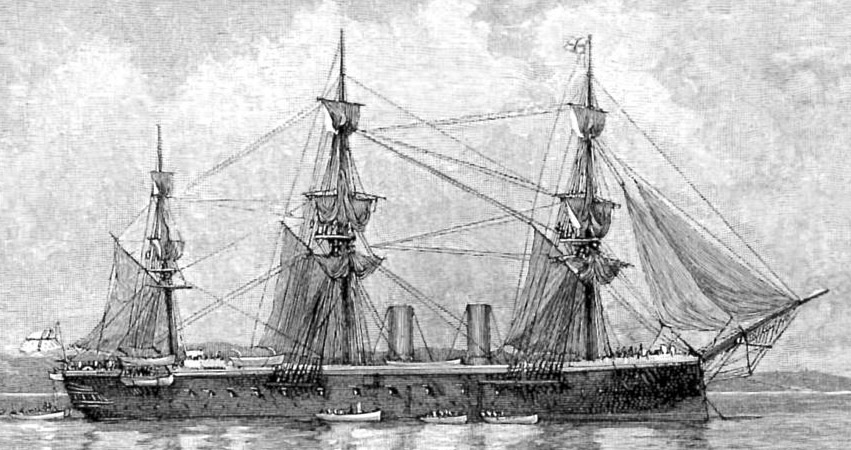
The HMS Inconstant, which can have been an influence on the design
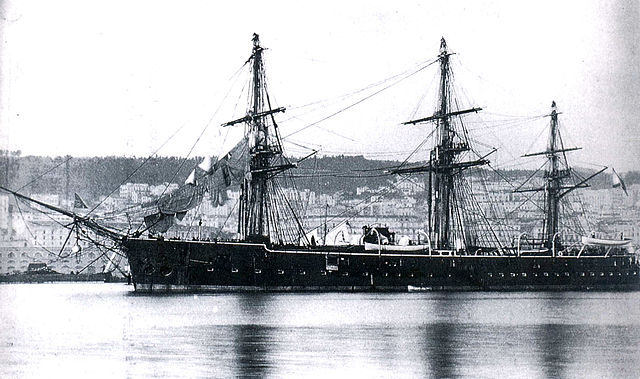
General Admiral in 1880
Sources
wikipedia.org/wiki/Russian_cruiser_Minin (Russian)
navypedia.org/ships/russia/ru_cr_minin.htm
Naval Warfare, 1815-1914 By Lawrence Sondhaus
naval-encyclopedia.com/ww1/pages/russia/russie1914d.htm
Conways all the word fighting ships 1860-1905
en.wikipedia.org/wiki/General-Admiral-class_cruiser

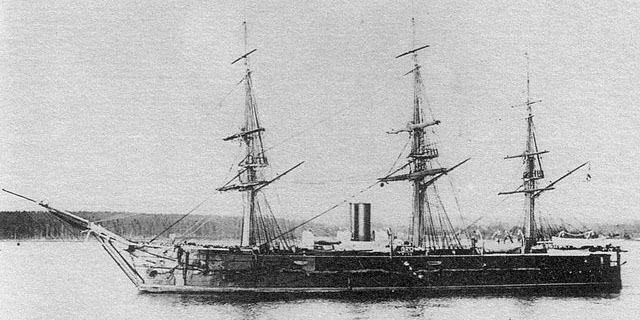

 Latest Facebook Entry -
Latest Facebook Entry -  X(Tweeter) Naval Encyclopedia's deck archive
X(Tweeter) Naval Encyclopedia's deck archive Instagram (@navalencyc)
Instagram (@navalencyc)





 French Navy
French Navy Royal Navy
Royal Navy Russian Navy
Russian Navy Armada Espanola
Armada Espanola Austrian Navy
Austrian Navy K.u.K. Kriegsmarine
K.u.K. Kriegsmarine Dansk Marine
Dansk Marine Nautiko Hellenon
Nautiko Hellenon Koninklije Marine 1870
Koninklije Marine 1870 Marinha do Brasil
Marinha do Brasil Osmanlı Donanması
Osmanlı Donanması Marina Do Peru
Marina Do Peru Marinha do Portugal
Marinha do Portugal Regia Marina 1870
Regia Marina 1870 Nihhon Kaigun 1870
Nihhon Kaigun 1870 Preußische Marine 1870
Preußische Marine 1870 Russkiy Flot 1870
Russkiy Flot 1870 Svenska marinen
Svenska marinen Søværnet
Søværnet Union Navy
Union Navy Confederate Navy
Confederate Navy Armada de Argentina
Armada de Argentina Imperial Chinese Navy
Imperial Chinese Navy Marinha do Portugal
Marinha do Portugal Mexico
Mexico Kaiserliche Marine
Kaiserliche Marine 1898 US Navy
1898 US Navy Sovietskiy Flot
Sovietskiy Flot Royal Canadian Navy
Royal Canadian Navy Royal Australian Navy
Royal Australian Navy RNZN Fleet
RNZN Fleet Chinese Navy 1937
Chinese Navy 1937 Kriegsmarine
Kriegsmarine Chilean Navy
Chilean Navy Danish Navy
Danish Navy Finnish Navy
Finnish Navy Hellenic Navy
Hellenic Navy Polish Navy
Polish Navy Romanian Navy
Romanian Navy Turkish Navy
Turkish Navy Royal Yugoslav Navy
Royal Yugoslav Navy Royal Thai Navy
Royal Thai Navy Minor Navies
Minor Navies Albania
Albania Austria
Austria Belgium
Belgium Columbia
Columbia Costa Rica
Costa Rica Cuba
Cuba Czechoslovakia
Czechoslovakia Dominican Republic
Dominican Republic Haiti
Haiti Hungary
Hungary Honduras
Honduras Estonia
Estonia Iceland
Iceland Eire
Eire Equador
Equador Iran
Iran Iraq
Iraq Latvia
Latvia Liberia
Liberia Lithuania
Lithuania Mandchukuo
Mandchukuo Morocco
Morocco Nicaragua
Nicaragua Persia
Persia San Salvador
San Salvador Sarawak
Sarawak Uruguay
Uruguay Venezuela
Venezuela Zanzibar
Zanzibar Warsaw Pact Navies
Warsaw Pact Navies Bulgaria
Bulgaria Hungary
Hungary

 Bundesmarine
Bundesmarine Dutch Navy
Dutch Navy Hellenic Navy
Hellenic Navy Marina Militare
Marina Militare Yugoslav Navy
Yugoslav Navy Chinese Navy
Chinese Navy Indian Navy
Indian Navy Indonesian Navy
Indonesian Navy JMSDF
JMSDF North Korean Navy
North Korean Navy Pakistani Navy
Pakistani Navy Philippines Navy
Philippines Navy ROKN
ROKN Rep. of Singapore Navy
Rep. of Singapore Navy Taiwanese Navy
Taiwanese Navy IDF Navy
IDF Navy Saudi Navy
Saudi Navy Royal New Zealand Navy
Royal New Zealand Navy Egyptian Navy
Egyptian Navy South African Navy
South African Navy






























 Ukrainian Navy
Ukrainian Navy dbodesign
dbodesign
Many congratulations on your online museum website. I am attempting researching a watercolour of a ironclad cruiser that I am trying to identify. Comparison to illustrations that I have found suggests that it might be a General Admiral class ship, but in all honesty, my maritime knowledge is limited . I wondered if I could perhaps send you an image of it for your opinion? If so, can you provide me with an email address.
I look forward to hearing from you.
Thanks Neil,
Of course ! You can contact me on [email protected] or [email protected]
Cheers,
David B, NE manager